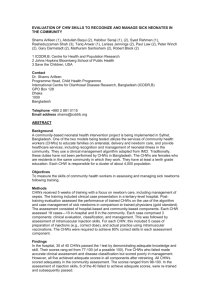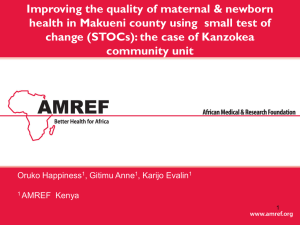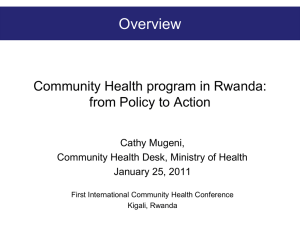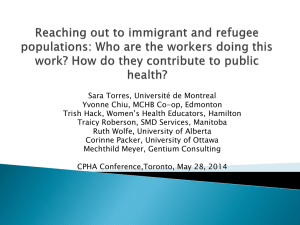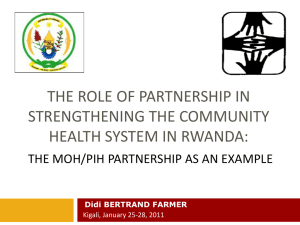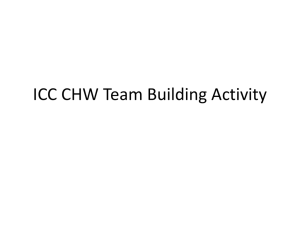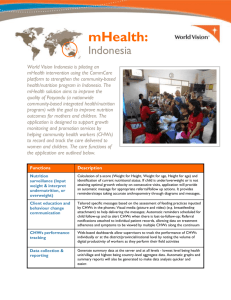testing_an_integrated_care_group_model_for_community
advertisement
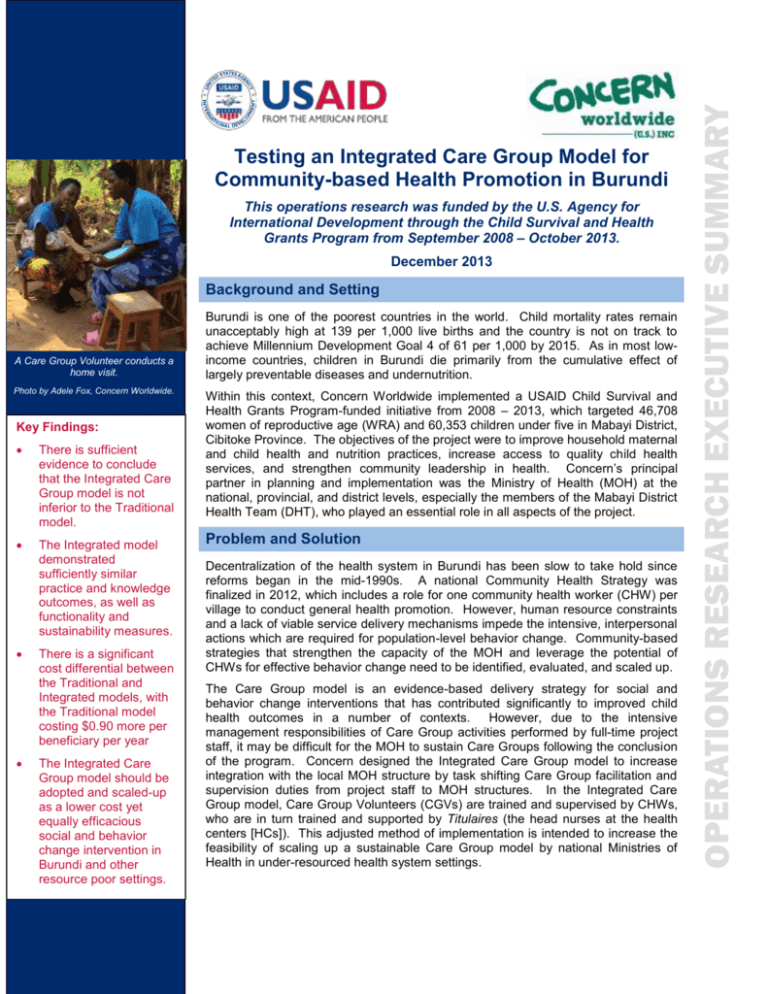
This operations research was funded by the U.S. Agency for International Development through the Child Survival and Health Grants Program from September 2008 – October 2013. December 2013 Background and Setting A Care Group Volunteer conducts a home visit. Photo by Adele Fox, Concern Worldwide. Key Findings: There is sufficient evidence to conclude that the Integrated Care Group model is not inferior to the Traditional model. The Integrated model demonstrated sufficiently similar practice and knowledge outcomes, as well as functionality and sustainability measures. There is a significant cost differential between the Traditional and Integrated models, with the Traditional model costing $0.90 more per beneficiary per year The Integrated Care Group model should be adopted and scaled-up as a lower cost yet equally efficacious social and behavior change intervention in Burundi and other resource poor settings. Burundi is one of the poorest countries in the world. Child mortality rates remain unacceptably high at 139 per 1,000 live births and the country is not on track to achieve Millennium Development Goal 4 of 61 per 1,000 by 2015. As in most lowincome countries, children in Burundi die primarily from the cumulative effect of largely preventable diseases and undernutrition. Within this context, Concern Worldwide implemented a USAID Child Survival and Health Grants Program-funded initiative from 2008 – 2013, which targeted 46,708 women of reproductive age (WRA) and 60,353 children under five in Mabayi District, Cibitoke Province. The objectives of the project were to improve household maternal and child health and nutrition practices, increase access to quality child health services, and strengthen community leadership in health. Concern’s principal partner in planning and implementation was the Ministry of Health (MOH) at the national, provincial, and district levels, especially the members of the Mabayi District Health Team (DHT), who played an essential role in all aspects of the project. Problem and Solution Decentralization of the health system in Burundi has been slow to take hold since reforms began in the mid-1990s. A national Community Health Strategy was finalized in 2012, which includes a role for one community health worker (CHW) per village to conduct general health promotion. However, human resource constraints and a lack of viable service delivery mechanisms impede the intensive, interpersonal actions which are required for population-level behavior change. Community-based strategies that strengthen the capacity of the MOH and leverage the potential of CHWs for effective behavior change need to be identified, evaluated, and scaled up. The Care Group model is an evidence-based delivery strategy for social and behavior change interventions that has contributed significantly to improved child health outcomes in a number of contexts. However, due to the intensive management responsibilities of Care Group activities performed by full-time project staff, it may be difficult for the MOH to sustain Care Groups following the conclusion of the program. Concern designed the Integrated Care Group model to increase integration with the local MOH structure by task shifting Care Group facilitation and supervision duties from project staff to MOH structures. In the Integrated Care Group model, Care Group Volunteers (CGVs) are trained and supervised by CHWs, who are in turn trained and supported by Titulaires (the head nurses at the health centers [HCs]). This adjusted method of implementation is intended to increase the feasibility of scaling up a sustainable Care Group model by national Ministries of Health in under-resourced health system settings. OPERATIONS RESEARCH EXECUTIVE SUMMARY Testing an Integrated Care Group Model for Community-based Health Promotion in Burundi Concern Worldwide implemented the Traditional and Integrated Care Group models in two clusters of Bukinanyana Commune. Care Groups were established in the same way in both study areas using standard Care Group practices, including community sensitization to Care Groups, census of all households with pregnant women and children under five, and election of CGVs based on census results. Based on formative research and the project’s technical intervention areas, behavior change modules were developed and used to promote evidence-based nutrition, malaria, diarrhea and pneumonia management behaviors. In both study areas, Care Group meetings were held twice per month and CGVs conducted home visits at least once per month, during which they provided targeted health promotion messages, screened for acute malnutrition, and collected vital events data. In the Traditional Care Group study area, paid Project Animators supervised Promoters, who in turn supervised CGVs. CHWs in the Traditional area may have also assisted with CGV supervision by carrying out household visits to ensure that CGVs had effectively delivered messages. In the Integrated area, CHWs supervised CGVs by conducting follow-up household visits, reviewing CGV registers, and trouble-shooting problems during Care Group meetings. CHWs in both study areas are supervised by health facility-based Titulaires, as dictated in the Community Health Strategy. Methods The study was conducted in Bukinanyana Commune, one of three mountainous and rural communes in Mabayi District, Cibitoke Province, Burundi. The five MOH zones in Bukinanyana Commune were grouped into two clusters based on population size. Each cluster was then randomly assigned to either the intervention area (Integrated Care Groups) or comparison area (Traditional Care Groups). The Care Group models were assessed to determine whether the Integrated model achieved the same levels of knowledge and practices of key child health and nutrition behaviors among caregivers of children age 0-23 months as the Traditional model (Hypothesis 1) and whether the Integrated model achieved the same level of functionality and sustainability as the Traditional model (Hypothesis 2). Hypothesis 1 was assessed through measuring 40 key child health and nutrition knowledge and practice indicators related to diarrhea, malaria, pneumonia, and nutrition. Data was collected through baseline (October 2010) and endline (May 2013) surveys of caregivers of children age 0-23 months, with noninferiority statistical testing conducted at endline. Hypothesis 2 was assessed through monthly monitoring of five Care Group key operational indicators, such as Care Group meeting attendance, home visits conducted, and reporting in both Traditional and Integrated areas. A qualitative process evaluation was also conducted at mid-term and was designed to document the successes, challenges, and changes associated with implementation of both the Traditional and Integrated Care Group models in a prospective manner. A total of 15 focus group discussions (FGDs), five in-depth interviews, and 20 non-participant observations were completed. Findings Hypothesis I: Overall, there is strong evidence that the Integrated model is not inferior to the Traditional model. Thirty-six of the forty indicators (90%) were not inferior in the Integrated area. The non-inferiority of the Integrated model is particularly evident among the practice indicators, with only one practice indicator being inferior in the Integrated Area. Non-inferiority was more moderate among the knowledge indicators, primarily because of lower than expected knowledge among mothers of food intake requirements for children at different ages. Hypothesis II: Overall, all five Care Group operational indicators nearly met or surpassed project targets, and there was no significant difference in Care Group functionality between the two models. Care Group functionality fluctuated during the project, but the models performed similarly towards the end of Concern’s support to Care Group activities. The sustainability measures demonstrate similar outcomes, with a somewhat better sustainability trend in the Integrated model compared to the Traditional model. The mid-term process evaluation highlighted that CHW supervision by health facility staff was an ongoing challenge in both study areas. As a solution, Concern worked with the Titulaire to identify an alternate ‘focal point’ for all Care Group activities, usually a more junior nurse who had fewer time constraints. The process evaluation also found that the CHWs had taken on a more active role in Care Group meeting facilitation and reporting in the Traditional area than had originally been anticipated. Concern did not discourage CHWs from taking more of a leadership role in Care Group activities in the OPERATIONS RESEARCH EXECUTIVE SUMMARY Intervention Conclusions There is sufficient evidence to conclude that the Integrated Care Group model is not inferior to the Traditional model. The Integrated model demonstrated sufficiently similar knowledge and practice outcomes, as well as functionality and sustainability measures. This research has also reinforced the existing evidence that Care Groups are a highly effective strategy to achieving key child survival priorities. CGVs are a valuable source of health education messages in their community, and the Integrated Care Group model demonstrates how CGVs provide a means to extend the reach of CHWs to achieve high levels of behavior change at the individual and household levels. In addition, and as similarly demonstrated in other Care Group projects, CGVs are able to effectively collect and report community health information system (C-HIS) data, including vital events. The Integrated Care Group model demonstrates how such data may be integrated into national HIS through both CGVs and CHWs. In addition to being a lower cost model, there are clear positive externalities to the Integrated model compared to the Traditional model. Through training and supervising CGVs in the Integrated area, the CHWs simultaneously strengthen their own knowledge and skills, as well as their ability to deliver quality health services to their target households. Moreover, CHWs gain a higher status in the community as they engage in supervisory activities comparable to non-governmental organization (NGO) staff. Recommendations Concern recommends that the Integrated model be scaled-up in Burundi and that CGVs be integrated as a formal component of the community health system to improve coverage of key health and nutrition interventions at the individual and household levels. Existing CHW performance-based financing (PBF) policies could be revised to include key Care Group operational indicators to further incentivize and institutionalize the model. While NGOs will still have a role in the medium-term to build the capacity of the MOH at the district level to implement the Integrated model, it is conceivable that the model could be scaled-up and institutionalized within existing community health structures. A final recommendation is to prioritize funding for future sustainability studies on this research. Given that this study only provides initial estimates of sustainability, Concern recommends that further research examining health and nutrition outcomes, as well as Care Group operational indicators, be conducted in both the Integrated and Traditional study areas within the next two years. Use of Evidence Throughout this operations research (OR) study, the MOH has demonstrated a keen interest in the potential of the Integrated Care Group model. MOH representatives have praised the model for its ability to extend coverage of key interventions to all eligible households, strengthen linkages between the community and health facilities, and incorporate C-HIS data into the national HIS. The official findings from this study were shared with the MOH, UNICEF, and other in-country development partners in September 2013 and will be used as a basis for continued advocacy in the coming years. The Mabayi Child Survival Project in Mabayi District, Cibitoke Province, Burundi is supported by the American people through the United States Agency for International Development (USAID) through its Child Survival and Health Grants Program. The Mabayi Child Survival Project is managed by Concern Worldwide under Cooperative Agreement No. GHN-A-00-08-00005. The views expressed in this material do not necessarily reflect the views of USAID or the United States Government. For more information about the Mabayi Child Survival Project, visit: www.concernusa.org. OPERATIONS RESEARCH EXECUTIVE SUMMAR Traditional area, and believes it is a sign of community approval of the structure of the Integrated model. That said, although Promoters did maintain lead responsibility for all Care Group facilitation and supervision duties, it is possible that the greater CHW involvement in the Traditional area diluted the differences between the two models as they were tested over the life of the study.
